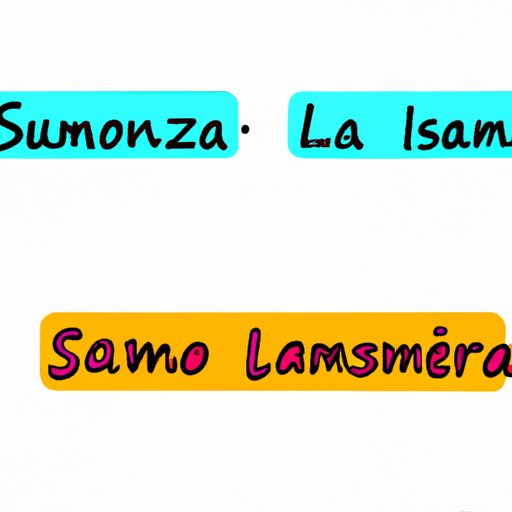Introduction
One of the first things you learn when studying a new language is how to introduce yourself. However, many people struggle with how to say “What is your name?” in Spanish. In this article, we will explore the different ways to ask for someone’s name in Spanish, as well as how to respond. By the end of this article, you’ll have the knowledge and confidence to ask for someone’s name in Spanish.
“Hola, ¿Cómo te llamas?” Exploring the Common Phrase for “What is Your Name?” in Spanish
One of the most common ways to ask for someone’s name in Spanish is by using the phrase “Hola, ¿Cómo te llamas?” This is a simple and friendly way to introduce yourself and start a conversation with someone new. The phrase literally translates to “Hello, what do you call yourself?”
Here are some example sentences using this phrase:
- Hola, ¿Cómo te llamas? – Hello, what’s your name?
- Me llamo Ana, ¿y tú? – My name is Ana, and you?
- Encantado de conocerte, ¿cómo te llamas? – Nice to meet you, what’s your name?
The Basics of Introductions: How to Say “What is Your Name?” in Spanish
Knowing how to ask for someone’s name is an important part of introductions. In addition to “Hola, ¿Cómo te llamas?” there are a few other phrases and vocabulary words you should know when introducing yourself to someone in Spanish:
- Yo soy… – I am…
- ¿De dónde eres? – Where are you from?
- Mucho gusto – Nice to meet you
- Adiós – Goodbye
- Por favor – Please
- Gracias – Thank you
Uncovering the Different Ways to Ask “What is Your Name?” in Spanish
While “Hola, ¿Cómo te llamas?” is the most common phrase for asking for someone’s name in Spanish, there are other phrases you might encounter as well. Here are a few others:
- ¿Cómo se llama? – What’s his/her/your name?
- ¿Cómo te dicen? – What do they call you?
- ¿Cómo te apellidas? – What’s your surname?
- ¿Quieres decirme tu nombre? – Can you tell me your name?
It’s important to note that some of these phrases are more formal than others, and you should use them accordingly based on the setting and the person you’re speaking to.
“¿Cuál es tu nombre?” and Other Formal Ways to Say “What is Your Name?” in Spanish
While “Hola, ¿Cómo te llamas?” is a friendly and informal way to ask for someone’s name, there are times when you might need to use more formal language. For example, if you’re speaking to an older person or someone in a position of authority, you might want to use a more formal phrase like “¿Cuál es su nombre?”
Here are some other formal phrases you might use:
- ¿Cómo se llama usted? – What’s your name? (formal)
- ¿Me permites preguntarte tu nombre? – May I ask your name? (formal)
- ¿Podría decirme su nombre? – Could you tell me your name? (formal)
How to Respond to “¿Cómo se llama usted?” and Similar Phrases in Spanish
When someone asks you for your name in Spanish, you’ll want to be sure you know how to respond. The most common way to answer is simply by saying “Me llamo…” followed by your name. For example, “Me llamo Juan.”
Here are a few other ways you might respond:
- Mi nombre es… – My name is…
- Soy… – I’m…
- No tengo nombre – I don’t have a name
From “¿Quién eres?” to “¿Cómo se llama tu amigo?” – Learning to Ask and Answer “What is Your Name?” in Spanish
Asking for and offering someone’s name is a building block for other social interactions. Here are some example dialogues of different situations where asking for someone’s name might come up:
- Meeting a new person: Hola, ¿Cómo te llamas? – Hello, what’s your name? / Hola, me llamo Ana, ¿y tú? – Hello, my name is Ana, and you?
- Asking for someone’s friend’s name: ¿Cómo se llama tu amigo? – What’s your friend’s name? / Se llama Luis – His name is Luis
- Introducing yourself to a group: Hola a todos, me llamo Pablo – Hi everyone, my name is Pablo
Conclusion
Asking for someone’s name in Spanish is a crucial step in language learning and socializing with Spanish speakers. Now that you know the different ways to say “What is your name?” in Spanish and how to respond, practice using these phrases in conversation and you’ll be well on your way to fluency.
